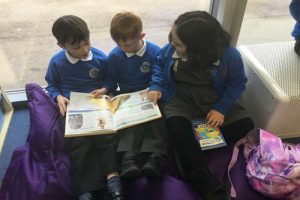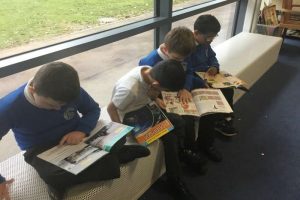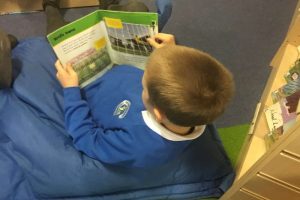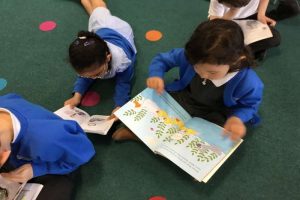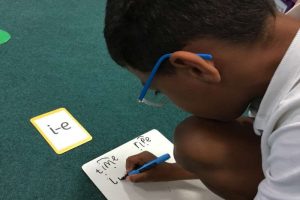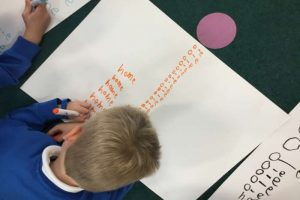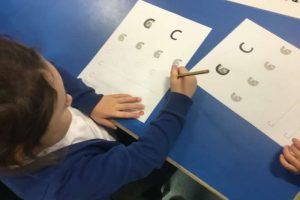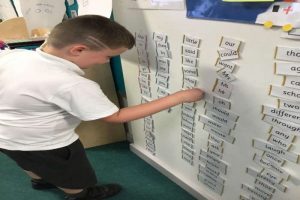Phonics & Early Reading
Intent:
We believe that all our children can become fluent readers and writers. This is why we teach reading through Little Wandle Letters and Sounds Revised, which is a systematic and synthetic phonics programme. We start teaching phonics in Reception and follow the Little Wandle Letters and Sounds Revised progression, which ensures children build on their growing knowledge of the alphabetic code, mastering phonics to read and spell as they move through school.
As a result, all our children are able to tackle any unfamiliar words as they read. We also model the application of the alphabetic code through phonics in guided reading and shared writing, both inside and outside of the phonics lesson and across the curriculum. We have a strong focus on language development for our children because we know that speaking and listening are crucial skills for reading and writing in all subjects.
Because we believe teaching every child to read is so important, we have a Phonics Leader who drives the early reading programme in our school. This person is highly skilled at teaching phonics and reading, and they monitor and support the teaching of phonics and reading so everyone teaches with fidelity to the Little Wandle Letters and Sounds Revised programme.
Aims:
Here at Cupernham Infant School, we value reading as a crucial life skill. Our aim by the time children leave us, is that they read confidently for meaning and regularly enjoy reading for pleasure. We make sure our readers are equipped with the tools to tackle unfamiliar vocabulary. We actively encourage our children to see themselves as readers for both pleasure and purpose.
Implementation:
Daily phonics lessons in Reception and Year 1
We teach phonics for 20 minutes a day. Each Friday, we review the week’s teaching to help children become fluent readers.
Children make a strong start in Reception: teaching begins at the beginning of the Autumn term.
We follow the Little Wandle Letters and Sounds Revised expectations of progress:
Children in Reception are taught to read and spell words using Phase 2 and 3 GPCs, and words with adjacent consonants (Phase 4) with fluency and accuracy.
Children in Year 1 review Phase 3 and 4 and are taught to read and spell words using Phase 5 GPCs with fluency and accuracy.
Keep-up lessons ensure every child learns to read
Any child who needs additional practice has ‘keep-up’ support, taught by a fully trained adult. ‘Keep-up’ lessons match the structure of class teaching, and use the same procedures, resources and mantras, but in smaller steps with more repetition, so that every child secures their learning.
We timetable daily phonics lessons for any child in Year 2 who is not fully fluent at reading or has not passed the Phonics Screening Check. These children urgently need to catch up, so the gap between themselves and their peers does not widen. We use the Little Wandle Letters and Sounds Revised assessments to identify the gaps in their phonic knowledge and teach to these using the ‘keep-up’ resources – at pace.
If any child in Year 2 has significant gaps in their phonic knowledge when reading or writing, we teach phonics ‘catch-up’ lessons to address specific reading/writing gaps. These lessons are a fast track version of the Little Wandle phonics programme taught in Year R and 1.
Teaching reading: Reading practice sessions three times a week
We teach children to read through reading practice sessions three times a week. These are taught by a fully trained adult to small groups of approximately six children, use books matched to the children’s secure phonic knowledge using the Little Wandle Letters and Sounds Revised assessments and book matching grids. These are monitored by the class teacher, who rotates and works with each group on a regular basis.
Each reading practice session has a clear focus, so that the demands of the session do not overload the children’s working memory. The reading practice sessions have been designed to focus on three key reading skills:
- decoding
- prosody: teaching children to read with understanding and expression
- comprehension: teaching children to understand the text.
In Reception these sessions start in the Autumn term. Children who are not yet decoding have daily additional blending practice in small groups, so that they quickly learn to blend and can begin to read books.
In Year 2, we continue to teach reading in this way for any children who still need to practise reading with decodable books.
Ensuring consistency and pace of progress
Every teacher in our school has been trained to teach reading, so we have the same expectations of progress. We all use the same language, routines and resources to teach children to read so that we lower children’s cognitive load.
Weekly content grids map each element of new learning to each day, week and term for the duration of the programme.
Lesson templates, prompt cards and ‘how to’ videos ensure teachers all have a consistent approach and structure for each lesson.
The Phonics Leader uses lesson templates to regularly monitor and observe teaching. Summative data is used during Pupil Progress meetings to identify children who need additional support.
Ensuring reading for pleasure
We regularly read to children because we want children to experience a wide range of books, including books that reflect the children at The Cupernham Infant School and our local community as well as books that open windows into other worlds and cultures.
All children have a home reading record where the parent/carer can record comments to share with the adults in school.
Children in all year groups have a weekly library slot where they can choose their own books to take home and share with their families.
Every Friday, every child and adult in the school takes part in ‘Everybody Reads’. This is a session where everyone in the school has the chance to drop everything and enjoy reading for pleasure. This also gives everyone the opportunity to discuss books and share their favourites.
Impact: Assessment
Assessment is used to monitor progress and to identify any child needing additional support as soon as they need it.
Assessment for learning is used:
- daily within class to identify children needing ‘keep-up’ support
- weekly in the review lesson to assess gaps, address these immediately and secure fluency of GPCs, words and spellings.
Summative assessment is used:
- every six weeks to assess progress, to identify gaps in learning that need to be addressed, to identify any children needing additional support and to plan the ‘keep-up’ support that they need.
- by SLT and scrutinised through the Little Wandle Letters and Sounds Revised assessment tracker, to narrow attainment gaps between different groups of children and so that any additional support for teachers can be put into place.
The Little Wandle Letters and Sounds Revised placement assessment is used:
- with any child new to the school to quickly identify any gaps in their phonic knowledge and plan appropriate extra teaching.
Statutory assessment:
Children in Year 1 sit the Phonics screening check. Any child not passing the check re-sits it in Year 2.
Children in Year 2 are assessed through:
- their teacher’s ongoing formative assessment
- the Little Wandle Letters and Sounds placement assessment
- the appropriate half-termly assessments.
Phonics Subject Overview and Progression:
Little Wandles Progression:
